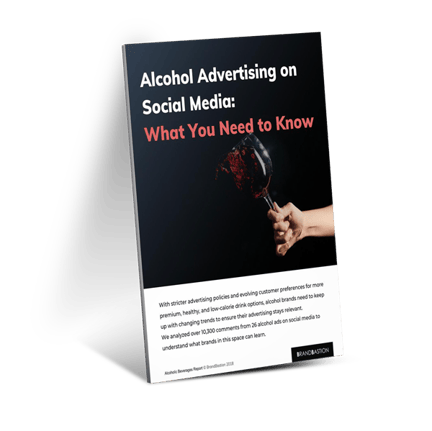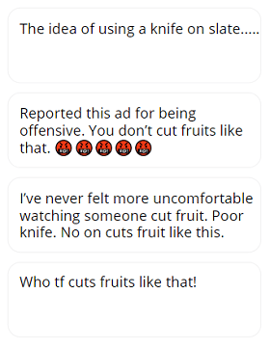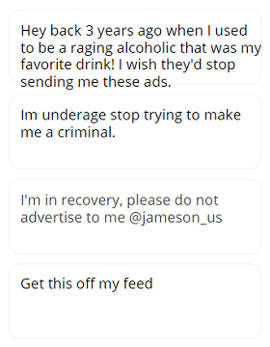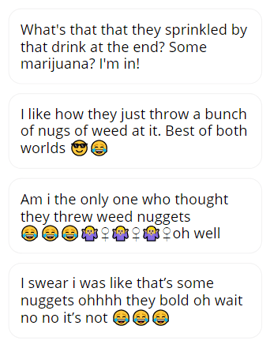REPORT
Alcohol Advertising on Social Media: Insights Report
With stricter advertising policies and evolving customer preferences for more premium, healthy, and low-calorie drink options, alcohol brands need to keep up with changing trends to ensure their advertising stays relevant. We analyzed over 10,300 comments from 26 alcohol ads on social media to understand what brands in this space can learn.
Download the Report
Highlights
∣ For the alcohol category, positive experiences with the product itself are what drives the overwhelming majority of positive comments on brands’ ads.
∣ Negative comments are focused on a mixture of products perceived to be poor quality and advertising creative that is perceived as inappropriate (e.g. advertising to those below legal age).
∣ We observed significant customer confusion over ingredients used in the ads that were mistaken for / associated with illicit substances.
Introduction
The alcoholic beverage market was valued at $1,344 billion in
Out of 10,334 comments, 3,187 (30.84%) were of positive sentiment, compared to 780 (7.55%) that were of negative sentiment.
The positive comments for all three brands’ ads were predominantly about the product itself. An overwhelming majority of these comments consisted of users tagging their friends and partners recommending them to try out the product being advertised, or telling their friends "I want to try this!"
People also discussed getting the products for specific occasions, including weddings, parties, and casual get-togethers. A small handful of positive comments were related to the ad creative, including the styling and how the video ads showcased specific ingredients like grapefruit and hops used in the products.
On average, 32.80% of all comments received per ad were positive. In terms of individual ads, the top 3 ads with the highest percentage of positive comments were for the Limited Edition Baileys Pumpkin Spice (56.49% of all comments received were positive), Baileys Almande ALMONDMILK Liqueur (53.43%), and Golden Road Brewing Mango Cart (52.36%).
TAKEAWAY #1: Happy customers increase an ad's reachHaving a good product and keeping customers satisfied increases the ROI of your social spend and extends the reach of campaigns, as users spread the ad’s reach organically by tagging their friends in the comments feed and recommending them to try the product.
Here’s a sampling of some of the comments that these three brands received:



Top 3 Ads With Most Negative Comments
Out of 10,334 comments, 780 (7.55%) were of negative sentiment, compared to 3,187 (30.84%) that were of positive sentiment.
On average, 14.34% of all comments received per ad were negative. In terms of individual ads, the top 3 ads with the highest percentage of negative comments were for Bud Light's "Roaring Conversations" (52.00%), michelobULTRA's
For the Bud Light ad, the majority of negative comments were related to the product itself, with many users criticizing its taste.
Conversely, in the
Whether triggered by the ad creative, the product, or ongoing social issues affecting
TAKEAWAY #2: Listen to what your customers have to say
The feedback from the comments thread contains valuable tips for future improvement and helps you spot issues with consumer perceptions about ads that you may not otherwise notice. From Vinebox's Summer Wine ad where people confused the shot samples with lip gloss or roll-on perfume, to criticism aboutmichelobULTRA's ad which was perceived as associating fighting cancer with drinking beer, to scrutiny of Stella Artois' social mission to "give water to the world" while Flint, Michigan still suffers from an ongoing water crisis - reactions like these provide important feedback for brands.
Here’s a sampling of some of the comments that these three brands received:



Want a similar analysis like this for your brand's campaigns? Click here
Ads With The Most Engagement
Overall, Jameson's IPA Edition ad garnered the most engagement with 3,886 comments and Samuel Adams' "Fill Your Glass" the least with 6 comments. (Note: This does not take into account the varying ad spend in order to achieve such engagement levels.)
The ad for Jameson's IPA was a video
A significant number of comments were positive about the product itself, with users commenting on how good it tastes or leaving their appreciation for the recipe and flavor combination featured in the ad. Many users tagged their friends in the comments to recommend that they try the product out.
On the other hand, the negative comments mostly consisted of comments about the ad creative, which showed a grapefruit being cut with a knife on a slate board - driving users to leave comments like:

A sizable proportion of negative comments were also related to the appropriateness of the ad, such as:

TAKEAWAY #3: Ensure you are advertising to the right audience.
In the U.S., while the Distilled Spirits Council’s Code of Conduct dictates that "digital marketing communications should be placed only in media where at least 71.6% of the audience is reasonably expected to be of the legal purchase age", in other countries, this age may vary or be older in other countries. Facebook's Audience Targeting tools allows you to select the right audiences so you don't violate these regulations.
Confused Customers
In addition to positive and negative sentiment, we looked at which ads had the most customer inquiries in the ad comments. We found that the Jameson Whiskey IPA

Meanwhile, on Vinebox's Summer Wine ad, people were also confused by the ad creative, which featured shot samplers in long,
Other Types of Engagement
Aside from measuring sentiment and customer queries, we found that on average, 4.01% of all comments in the ads analyzed contained a threat such as competitor mentions, discriminatory comments, extreme profanity, criminal use of drugs or intoxicants, sexual or toilet humor, all of which could be associated with the brand being advertised. The ads also contained comments containing industry-specific threats, such as regulatory issues related to underage drinking.
TAKEAWAY #4: Listen and moderate actively
Active social listening and moderation can significantly reduce the volume of competitor promotions, toilet humor, spam, brand attacks, and other types of harmful comments. In addition, great customer feedback can be found in the comments and can help you clarify your messaging, improve your creative, or discover new product ideas.




Recap of Takeaways
TAKEAWAY #1: Happy customers increase an ad's reach
Having a good product and keeping customers satisfied increases the ROI of your social spend and extends the reach of campaigns, as users spread the ad’s reach organically by tagging their friends in the comments feed and recommending them to try the product.
TAKEAWAY #2: Listen to what your customers have to say
The feedback from the comments thread contains valuable tips for future improvement and helps you spot technical issues about ads that you may not otherwise notice. From Vinebox's Summer Wine ad where people confused the shot samples with lip gloss or roll-on perfume, to criticism aboutmichelobULTRA's ad which was perceived as associating fighting cancer with drinking beer, to scrutiny of Stella Artois' social mission to "give water to the world" while Flint, Michigan still suffers from an ongoing water crisis - reactions like these provide important feedback for brands.
TAKEAWAY #3: Ensure you are advertising to the right audience.
In the U.S., while the Distilled Spirits Council’s Code of Conduct dictates that "digital marketing communications should be placed only in media where at least 71.6% of the audience is reasonably expected to be of the legal purchase age", in other countries, this age may vary or be older in other countries. Facebook's Audience Targeting tools
TAKEAWAY #4: Listen and moderate actively
Active social listening and moderation can significantly reduce the volume of competitor promotions, toilet humor, spam, brand attacks, and other types of harmful comments. In addition, great customer feedback can be found in the comments and can help you clarify your messaging, improve your creative, or discover new product ideas.
Our technology uses neural networks, natural language processing and machine learning for content processing. Our content processing system processes all comments and takes actions based on pre-configured guidelines. Our trained teams of quality assurance managers and content processing specialists oversee the processes ensuring we have the highest level of accuracy.
Limitations:
- This analysis mainly focuses on the most popular alcohol brands
- We analyzed only publicly visible comments
- Topics identified are based on current context and can change over time